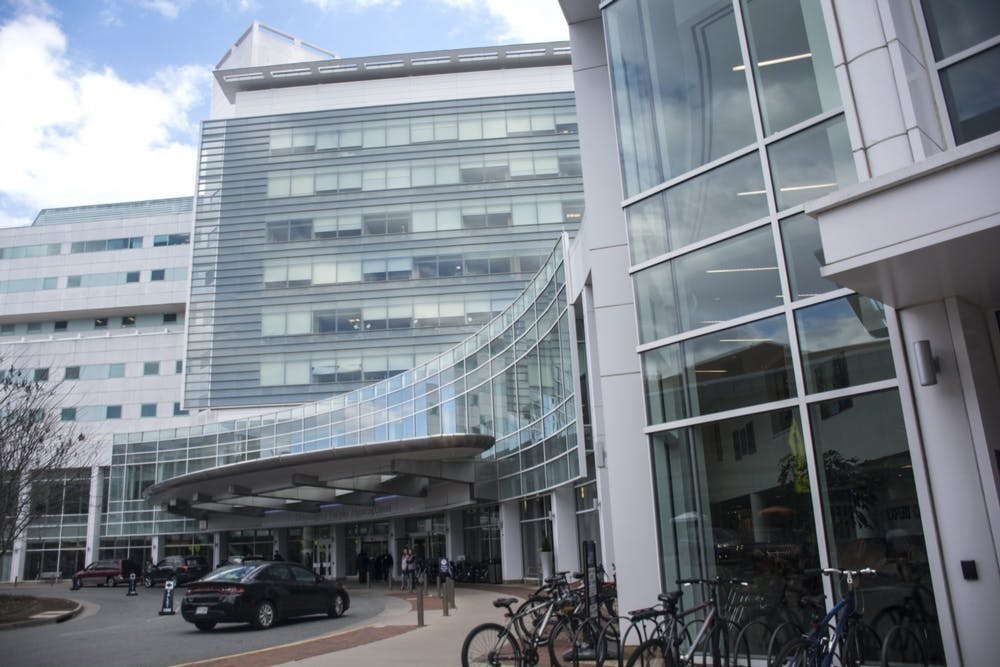The past eight months have left many COVID-19 questions unanswered. Earlier this summer, there was even more confusion about the virus’s long-term impact on the organs. To monitor those long-term health effects, Drs. Chintan Ramani and Alexandra Kadl on June 2 opened up a post-release clinic for patients discharged from U.Va. Medical Center’s COVID-19 Intensive Care Unit.
“For the ICU patients, we typically follow up with them about six weeks afterwards and assess their pulmonary health as well as their mental health,” Kadl, an assistant professor for medicine and pharmacology, said. “We have some screening forms for PTSD, for depression, for insomnia 一 for the cognitive function they do a [Montreal Cognitive Assessment] test to evaluate any issues there.”
So far, Kadl and Ramani said that their patients have been in relatively good health at the six week check-up. On July 30, Ramani published their initial findings in the medical journal Chest and reported that, of their 102 patients admitted to the ICU — all of whom were admitted for being “very sick” according to Kadl — 22 died, 21 remained hospitalized and 59 were discharged alive.
The median surviving patient age in that report was 56 years old, with the youngest patient being a 30 year old female and the oldest being a 75 year old male. Kadl was particularly surprised by how COVID-19 impacted patients’ cognitive function.
“We have seen very, very little neurocognitive impairment in our patients. We actually have been doing really well from that perspective,” Kadl said. “Very little depression and almost no PTSD, which was quite surprising to us.”
Kadl also said that although their patients’ respiratory systems were more affected than their cognitive function, their lung health was still generally improved at the initial checkups.
“Our patients have done fairly well. They have been all off oxygen. On their pulmonary function tests, we do see some abnormalities, we call them obstructive lung diseases and restrictive lung diseases, but six weeks after discharge, we can’t say for sure whether that’s permanent or whether that’s still a remnant of the hospitalization,” Kadl said.
The discharged patients had spent on average 10.6 days on “mechanical ventilation” during the ICU stays. At the follow-up appointments, which occurred approximately 38.4 days after discharge, 16 of the 28 patients’ spirometry — lung function — tests came back “normal,” five tests showed “restriction,” four tests showed “obstruction,” two tests were unable to be performed and one test showed “mixed obstruction and restriction.”
Kadl lauded her colleague Ramani for the clinic’s remarkably high participation rate. While Ramani said that other post-release clinics might only return between 40 and 60% of their patients for check-up appointments, Kadl said that she thought her colleague's personal phone calls to those discharged from U.Va.’s COVID-19 ICU were the reason that more than 90 percent of them returned after six weeks.
“I personally call them and then explain to them why we want to see them back in the clinic,” Ramani said. “Two-to-three days before, I actually give them a call again to see what’s going on and if there’s any barrier that they could not make it and again explain to them why it’s necessary for them to come to the clinic and what we’re looking for.”
In the next few weeks, they will expand their patient pool from exclusively ICU-discharged patients to all hospital-discharged COVID patients at the U.Va. Medical Center. Kadl said she hoped that this expansion will answer some of their remaining questions about how the virus impacts people after they stave off the initial infection.
“The thing we really want to look into with the expansion to non-ICU patients is to look at whether the infection by itself, regardless of how severe it was, will have long standing effects on lung health,” Kadl said. “We know that ICU patients may have long standing issues but we really haven’t focused — no one has really focused on non-ICU patients.”
In the midst of all the unknown surrounding COVID-19, Ramani claimed that his clinic’s patients so far had a different recovery trajectory than those in Europe and thought that it might have been because U.Va.’s COVID-19 ICU had a lower number of patients than hospitals in more densely populated urban areas.
“Our patient cohort didn’t really have much of the symptoms other than some of the pain issues and ongoing fatigue, as compared with European studies where they noticed they have ongoing cough, stomach issues, and so on and so forth,” Ramani said. “We were able to focus on our patients better than other places because they did have a lot more patients than us.”
As of Wednesday at 1:58 p.m., there were 20 inpatients at U.Va. Health confirmed with COVID-19 — nine of whom were in the Intensive Care Special Pathogens Unit and an additional nine in the Acute Care Special Pathogens Unit — according to an update sent to U.Va. Health employees obtained by The Cavalier Daily. 10 inpatients confirmed with COVID-19 were also being treated on ventilators at U.Va. Health.
Although recent numbers in the ICU have been low, Ramani is confident that it, along with the post-discharge clinic, are prepared to handle an increase in patient load.
“The number’s not that high, so that has helped us. I think we still have the capacity if there’s more numbers 一 we can accommodate,” Ramani said.
Kadl and Ramani were pleased with how their patients were recovering so far and even more pleased with the effective operation of their post-discharge clinic. In fact, Ramani said that he hopes to replicate the high patient capture rate of the COVID-19 ICU clinic to all ICU clinics at the University, if it continues functioning well.
“In the long run, I’m trying to change this from just the COVID-ICU to a general post-ICU clinic,” Ramani said. “Then I’ll have a better idea that we will still be able to capture the same amount of patients coming back to the clinic or not.”







